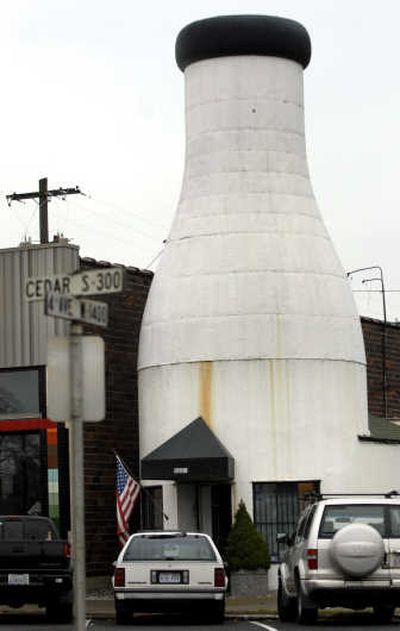Milk bottle building was retail outlet for Benewah Creamery

Long before “Got Milk?” became a ubiquitous national ad campaign for the dairy industry, it could easily have been the motto for the Benewah Milk Bottle at 321 S. Cedar in Spokane.
Actually, the milk bottle building really didn’t need any words to get the message across. Just look at it. Message understood.
The 38-foot-tall, stuccoed structure is 15 feet wide at its base and is an example of mimetic architecture, a style which creates structures depicting nonarchitectural objects (teapots, animals, etc.)
The Benewah Milk Bottle was built in 1935 – as was its sister structure at 802 W. Garland – as a retail outlet for creamery operator and merchant Paul E. Newport. Newport came to Spokane in 1922 from St. Maries, where he had started his dairy products business, the Benewah Creamery Co., named for Chief Benewah of the Coeur d’Alene Tribe.
Originally, he planned to build six milk bottle buildings in Spokane at a cost of about $3,700 each, but only completed the two. To celebrate their opening, Newport sponsored a soap box derby on the Post Street hill, just below the Garland Avenue store – an annual event which continued for years.
In addition to a plant which produced an assortment of dairy products, Newport had a half-dozen or so other traditional-looking retail outlet stores in the area, the last one of which closed in 1978. The Benewah Creamery Co. was defunct by 1979.
The store on Garland has since been a secondhand store and today, Mary Lou’s Milk Bottle sandwich, burger and ice cream store operates at the site. The Benewah Milk Bottle on Cedar, which is on the National Register of Historic Places, was vacant for a number of years, has been used as a storage space and today is home to the Spokane County Democratic Central Committee.
The well-known local architectural film of Whitehouse and Price made something of a whimsical leap from their other more stately architectural projects when they created the novelty milk bottle buildings back in the ‘30s. These delightful examples of literalism in advertising – where function, structure and material are less important than their representational quality – contrast significantly with Whitehouse and Price’s grand Cathedral of St. John the Evangelist, Hutton Settlement, Spokane Civic Building/Chamber of Commerce on Riverside in downtown Spokane and various homes and college administration buildings in Washington, Idaho, Oregon and Montana.
But, surely, none of those other structures can put a smile on your face by just catching a glimpse of them – or make you long for a moo-stache of your very own.